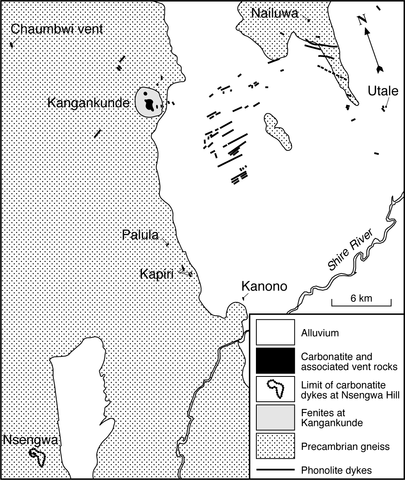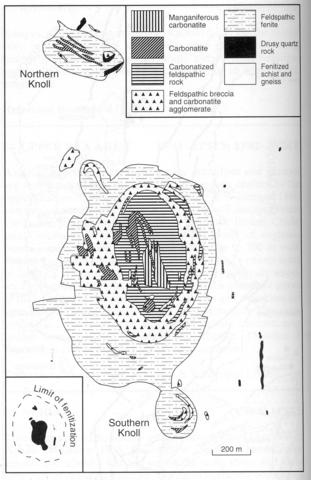stripes
Kangankunde is a carbonatite complex that is characterised by the almost total absence of associated igneous silicate rocks. It forms a low ridge that is underlain by an oval area of carbonatites of some 700x400 m around which is a broad collar of potassic feldspathic breccias, agglomerate and fenite. Beyond this collar the fenite zone extends for a further kilometre. The Northern and Southern Knolls are low hills to the north and south of the main complex in which carbonatite sheets have generated subsidiary systems of potassic fenite. The detailed mapping of Garson (1965b) was facilitated by extensive trenching and drilling (see Garson, 1965b, Maps 2 and 3). The carbonatite area is unusually complex with all gradations from clearly intrusive sheets and plugs that appear to owe their origin to ‘carbonatization’, and others that are mixtures of feldspathic fenite and carbonatite. Garson (1965b) mapped five carbonatite types namely apatite beforsite, carbonatite agglomerate, carbonatized feldspathic rock, intrusive carbonatite and mobilized carbonatized rock, and manganiferous carbonatite. However, apart from some of the sharply defined and clearly intrusive sheets, there are generally gradational contacts and distinctions are nor always clear. Further, there are many variations of structure, texture and mineralogy throughout the carbonatite area. The apatite carbonatite forms a plug-like body on the western margin of the carbonatite area as well as dykes at several localities. It is an enigmatic rock that Garson (1965b) shows was intruded prior to the main brecciation, and which he considers was altered by processes related to the carbonatisation and intrusion of the carbonatites. He postulates that it was originally a nephelinite or similar rock. The least altered rocks of the plug contain numerous phenocrysts of apatite, magnetite, sparse probable perovskite and much carbonated biotite, nepheline and olivine, the least altered of which has rims of melilite and possible monticellite. The least carbonated groundmass contains nepheline partly altered to cancrinite, apatite, an opaque phase and, in one specimen, as much as 10% melilite laths. Petrographic descriptions of the other occurrences of this rock type are in Garson (1965b). The carbonatite agglomerate generally forms an intermediate zone between feldspathic breccias and agglomerates and an inner zone of strongly carbonated rocks, but it also occurs as arcuate sheets within both of them. It comprises angular blocks of feldspathic breccia, up to about 0.5 m in diameter, in a sparse matrix of iron-rich carbonatite and, in some parts, manganese oxides. In places the feldspathic fraction has been partly or wholly replaced by fine-grained phlogopite and both fragments and matrix are cut by veinlets of ankeritic carbonate and phlogopite. There are minor disseminations of monazite, barite and strontianite. The carbonatised feldspathic rocks are the main rock type of the main carbonatite ‘plug’ and vary from only slightly carbonated rocks to types with only minor feldspar. These rocks are exceptionally complex, in places grading into apparently intrusive carbonatite dykes, and elsewhere ramified by streaks and veinlets of monazite-rich ankerite carbonatite, manganiferous carbonatite and apatite-rich material. Large areas of these rocks were also mobilised and intruded less heavily carbonated rocks. Thin sections reveal turbid feldspar being replaced to varying degrees by carbonate packed with iron oxide ‘dust’, patches of opaque iron oxides, some possibly pseudomorphing pyroxene or amphibole, and patches of clear carbonate with a little monazite, barite and quartz. Numerous detailed descriptions are given by Smith (in Garson, 1965b). The intrusive carbonatites and mobilised carbonatised rocks of the central area are mapped as sheets and arcuate zones but Garson (1965b) indicates that, apart from sheets cutting the feldspathic breccias and agglomerates, the distinction from the carbonatised feldspathic rocks is difficult to make as they generally merge into each other. However, in several areas the intrusive carbonatites are unambiguously defined and at the northern end of the complex, for instance, form sheets up to 50 m thick, while a plug at the southern end is some 60 m in diameter. All these carbonatites weather to a uniform dark brown colour, apart from creamy, late strontianite-rich veins that are up to 20 cm thick. A number of carbonatite types can be distinguished. ‘Sideritic carbonatites’ are fine-grained rocks comprising ankeritic carbonate packed with ‘limonitic material’, which Smith (in Garson, 1965b) thought was probably originally siderite, and turbid feldspar with some varieties rich in monazite. These rocks are cut by, and included as fragments within, white or cream-coloured carbonatites and quartz-barite-monazite-carbonate rocks. The carbonatites consist of clear ankerite, patches of a turbid carbonate, florencite and patches of quartz, monazite and sphalerite. There are various textural and mineralogical variants of these rocks including types with bastnasite, florencite, pyrochlore and fluorite. Manganiferous carbonatites occupy a broad zone in the central part of the complex and a surrounding ramifying system of black veins; they also occur as small dykes on the eastern slopes. They appear to have impregnated and veined the carbonatite agglomerates, carbonatized feldspathic rocks and the intrusive and mobilised carbonatites. They consist of ankerite crystals within which are patches, blebs and fingerprint-textured areas of iron and manganese oxides, streaks and patches of carbonate and radiating crystals of apatite; late drusy areas contain bastnasite, parisite, carbonate, quartz, barite and monazite. Analyses of these rocks indicate up to 17% manganese oxides. A drusy mineralization is disseminated throughout the carbonatite area many types of which are described by Garson (1965b). It involves rare earth minerals, barite, strontianite and the widespread development of green monazite which is ubiquitous in the carbonatites and in some areas is spectacularly developed. The fenites at Kangankunde, like those at Chilwa Island (No. 103-00-031) and Tundulu (No. 103-00-032), form a broad aureole in which a range of Precambrian metamorphic rocks have been affected with a distinctive inner aureole of potassic fenites that are clearly directly linked to the carbonatites. The carbonatite sheets on the Northern and Southern Knolls, for example, have their own collars of potassic fenite. Garson (1965b) considered that the fenitization was the first manifestation of igneous activity at Kangankunde and was contemporaneous with an updoming. The outermost fenites contain a network of fractures and veinlets along which aegirine is developed. Secondary blue sodic amphibole is widespread but more abundant in fenitised amphibole schists and amphibolites. Only in the innermost parts of the aureole are syenitic fenites free of quartz developed. The inner feldspathic breccia and agglomerate zone of Garson (1965b, Map 2) consists of K-feldspar rocks with some iron oxides. In some rocks the feldspar has been wholly or partly replaced by phlogopite. The contact between these rocks and the ‘normal’ fenites is rarely exposed but a hand specimen illustrated by Woolley (1969, Plate 9) shows feldspathic fenite forming a zone cutting the normal fenite. Analyses of four fenites are given by Woolley (1969). Analyses of eight carbonatites will be found in Garson (1969b) and Ziegler (1992) gives major and trace element, including REE and Rb-Sr and Sm-Nd isotopic data for two carbonatites. A probe study of two carbonatites by Buckley and Woolley (1990) demonstrated that the carbonate includes calcite, dolomite, ankerite and members of the magnesite-siderite series.
BUCKLEY, H.A. and WOOLLEY, A.R. 1990. Carbonates of the magnesite-siderite series from four carbonatite complexes. Mineralogical Magazine, 54: 413-8.CAHEN, L. and SNELLING, N.J. 1966. The geochronology of equatorial Africa. North-Holland Publishing Company, Amsterdam. 195 pp.GARSON, M.S. 1965d. The geology of the area west of Lake Malombe, Fort Johnston District. Records, Geological Survey of Malawi, 3: 35-48.GARSON, M.S. and MORGAN, D.J. 1978. Secondary strontianite at Kangankunde carbonatite complex, Malawi. Transactions, Institution of Mining and Metallurgy, 87B: 70-3.HOLT, D.N. 1965. The Kangankunde Hill rare earth prospect. Bulletin, Geological Survey of Malawi, 20: 1-130.WOOLLEY, A.R. 1969. Some aspects of fenitization with particular reference to Chilwa Island and Kangankunde, Malawi. Bulletin of the British Museum (Natural History), Mineralgy, 2: 189-219.ZIEGLER, U.R.F. 1992. Preliminary results of geochemistry, Sm-Nd and Rb-Sr studies of post-Karoo carbonatite complexes in southern Africa. Schweizerische Mineralogische und Petrographische Mitteilungen. Zurich, 72: 141-8.


